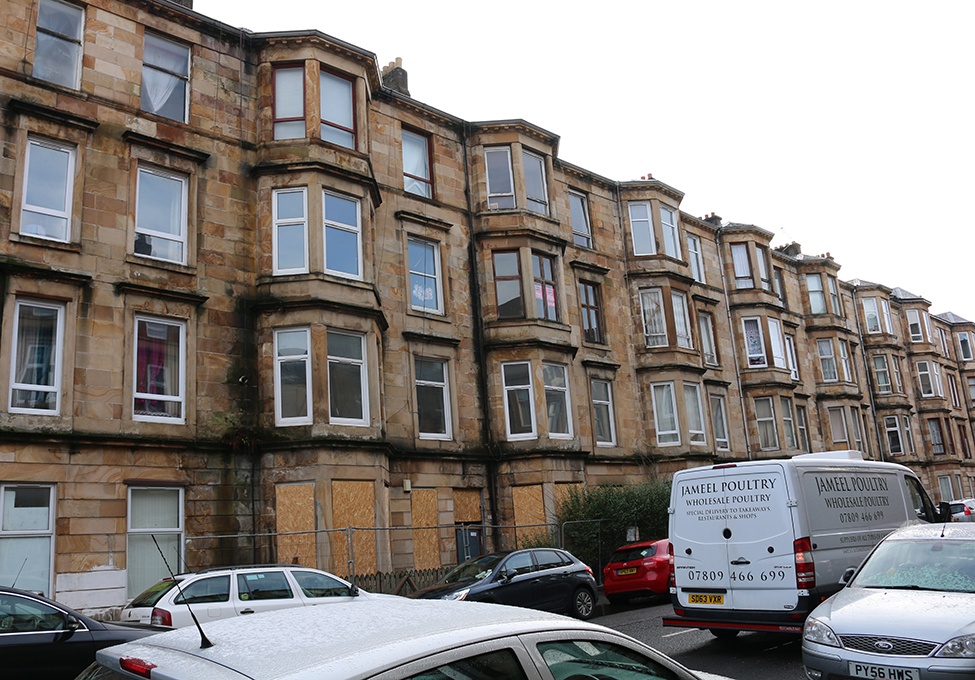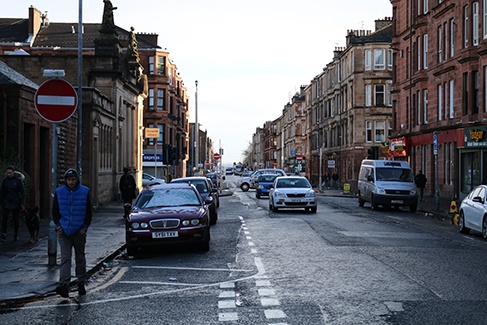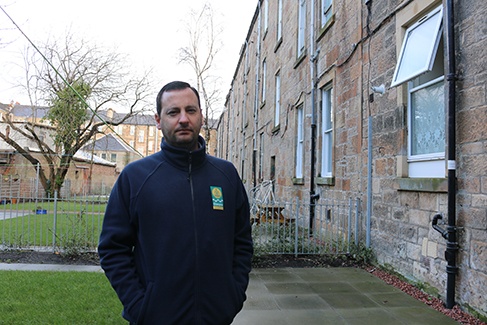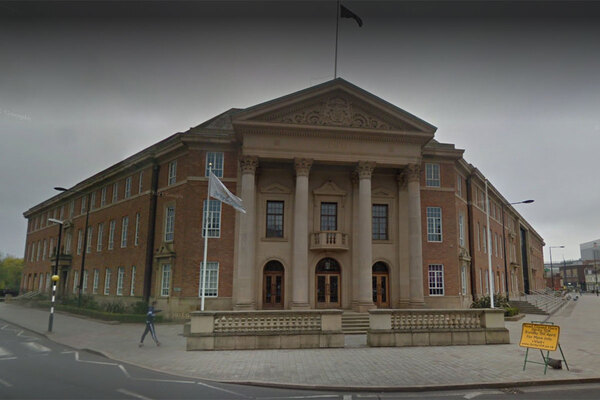You are viewing 1 of your 1 free articles
Glasgow takes on the rogues
Glasgow’s Govanhill district has been described as Scotland’s “biggest slum”, with private sector properties in dire conditions. James Andrew Smith meets the people set on turning it around
Video:
features style

Glasgow’s Southside once had a reputation for being cold and unforgiving. Standing in the green and white tiled hall of a Victorian tenement in the middle of January, it’s easy to see – and feel – why.
“When I first told family and friends I was going to work in Govanhill, their immediate reaction was: ‘Are you mad? Don’t you know what it’s like?’,” recalls Derek Lyon, senior project officer at Glasgow City Council, his breath visible in the freezing air. “But actually, now I say ‘no, you don’t know what Govanhill is like’.”
Video:
Ad slot
Govanhill is in the heart of Glasgow’s once-thriving docklands, where long-established working-class communities gave way to urban deprivation through the 20th century. Now, two decades of migration from Europe have again altered the neighbourhood.
Conditions are poor and relations between different groups of residents can be tense; some locals speak in the coded language of ‘Little Romania’, referencing the wave of Eastern European immigrants who have come to the area in recent years.
Activists from the Let’s Save Govanhill group recently dubbed the area “the biggest slum in Scotland”, highlighting problems such as rubbish on the streets, crumbling or infested properties, a lack of school places and high levels of poverty.
There has been investment, but not enough for some. “Govanhill has always got a larger share of resources in Glasgow, even before I came, but it was still very pressurised here,” says Soryia Siddique, Glasgow’s executive member for citizens and communities and a ward councillor for Southside.
Targeted assault
It is against this backdrop that Glasgow City Council, Govanhill Housing Association and the Scottish Government resolved to take on the most targeted assault on poor conditions in private sector housing anywhere in the UK.
“Govanhill has always got a larger share of resources in Glasgow, even before I came, but it was still very pressurised here.”
Soryia Siddique, Glasgow’s executive member for citizens and communities and a ward councillor for Southside
A three-pronged approach featuring beefed-up regulation and more investment was devised in negotiations between Holyrood and the council. The council was given a helping hand by provision in the Housing (Scotland) Act 2014, which had introduced mandatory private landlord registration and gave local authorities special powers to shut down private sector lets where conditions are poorest. An amendment to the act for ‘enhanced enforcement areas’ (EEAs) gave further powers for inspections, allowing councils to force entry into homes if necessary. So far, Govanhill is the only place in Scotland where a council has applied and successfully introduced such powers.

Tenement flats have been acquired from the private market
In addition, direct funding from the Scottish Government was provided to Govanhill Housing Association to buy back homes from the private market. Some £12m was invested and 124 tenement flats were acquired.
Restoring relations
Community engagement was also ramped up. Mr Lyon is one of 18 staff who routinely visit the properties to talk with tenants and landlords. They can stop properties from being rented out if they remain ‘below tolerable standard’. Inside Housing joins Mr Lyon and his colleague Anne Moran on the council’s outpost on the top floor of Govanhill Housing Association’s period offices before setting out on a visit.
“We want to restore a sense of community around here,” explains Mr Lyon. Ms Moran adds: “People need to take responsibility.”
The housing association’s offices are also home to local police representatives, and it holds regular forums for landlords where they can seek advice and air their grievances.
Council officers provide bespoke advice for tenants, many of whom will have only just moved to the UK and be unaware of the complex ‘factoring’ arrangements in tenement buildings, whereby a fee is paid to a ‘factor’ who manages the communal areas. In Govanhill, that can mean having an in-house interpreter.
The first visit of the day is to a two-bedroom flat, with a tiny kitchen and a hall where a table has only just been squeezed in. Four children run around us as the officers walk through the rooms.
The landlord, a slight man in a tracksuit, has agreed to meet the council to go over the repairs he was told to make. While the tenants go about their day, he points out all the work he’s done to try to bring the flat up to scratch: a fixed skirting board here, a safer light fitting there, and a rickety-looking ventilation system in the kitchen.
Mr Lyon, clearly unsatisfied, walks around by himself pointing out flaws: a shattered pane of glass above a door that would be a huge risk to the children, clearly unsafe and exposed wiring, and further light fittings that would need work.
“We want to restore a sense of community around here.”
Derek Lyon, senior project officer at Glasgow City Council
The home is below tolerable standard, but it’s only the first stage of the process. Mr Lyon tells the landlord he won’t take away his licence, but also offers a warning: “If you don’t get the work done, we’ll rehouse the tenants and have to shut this place down.”
These are not idle threats: in November 2016, the city council struck off nine landlords who had consistently failed to bring their flats up to standard. Although the scheme has been targeted across Govanhill, the EEA only covers four blocks seen as being at the heart of the area’s housing problems.
Other blocks are in a similarly bad condition, however. The Scottish Government has agreed to an expansion, with another £34m provided, covering 18 blocks across Govanhill. On the day of Inside Housing’s visit, one block is boarded up entirely.

Derek Lyon, Glasgow City Council
“With that one, the whole back wall collapsed, so all the tenants had to be moved out; we did warn them in good time, though,” explains Mr Lyon. “The problem is that residents further along the tenement, especially the shops, don’t see why they should have to pay for the costs of the repairs.”
This is a major part of the issue when it comes to the condition of Glasgow’s social housing stock. Under the rules governing tenements, a shared, voluntary responsibility is taken on by property owners of tenement blocks to look after the wider freehold. If there is no agreement in place, communal areas remain uncleaned and larger structural repairs – like subsistence – are left to get worse and worse.
“Some of the properties in this area sound absolutely horrific,” admits Chris Norris, head of policy at the National Landlords Association. “They’re described as ‘rogue landlords’ but it sounds like absolute criminality. It beggars belief they hadn’t been shut down sooner.”
Mr Norris suggests that the “vast majority of landlords” are not acting as irresponsibly as those the council is clamping down on. But while he doesn’t want this level of enforcement applied across the city, he agrees it can work on a localised basis.
Question of justice
“Certainly we would have hoped the lower levels of regulations would have put a stop to this by now, but considering this is a very targeted scheme it doesn’t look like an overreaction on that basis.”
Ms Siddique has other ideas, and would like to see the same level of scrutiny elsewhere. “I really think the EEA should be standard. It’s a question of social justice: tenants should have rights,” she says.
“I’d actually like to see this expanded across the whole of the city. The whole of Scotland, even.”
The officers’ next visit is to a quieter flat, where the landlord is thought to be living in Singapore.
“Some of the properties in this area sound absolutely horrific.”
Chris Norris, head of policy, National Landlords Association
A broken front window, gaping cracks in the walls and bed bugs show there is a long way to go before it can be classed as of a ‘tolerable standard’. Mr Lyon is initially worried about vermin, but fears are allayed when the noise he hears is found to be a squeaking floorboard.
“Have you seen a mouse?” he asks the tenants, whose broken English makes communication difficult. Eventually he shows them a picture on his phone, and the eldest son in the family points towards the kitchen and nods. “One,” he confirms.
As the inspectors move to the bedroom, the landlord enters without knocking, looking at them accusingly. His tone changes when he realises the situation, and he immediately begins trying to justify the conditions.
While Mr Lyon takes the landlord to task over bringing the flat up to standard, his colleague tries to convince him to vote for a factor. By having landlords like this elect a factor, she explains, communal and structural repairs can be properly dealt with. When he complains he can’t afford it, she offers an ultimatum: if he can’t make money from it, maybe Govanhill Housing Association should buy the property from him.
These tactics combined have seen more than 100 properties brought into housing association ownership in Govanhill, and with ownership comes an immediate factor vote and proper factoring arrangements.
For Mr Lyon, the fight over this flat has become personal: “I’ll get that block factored if it’s the last thing I do.”







